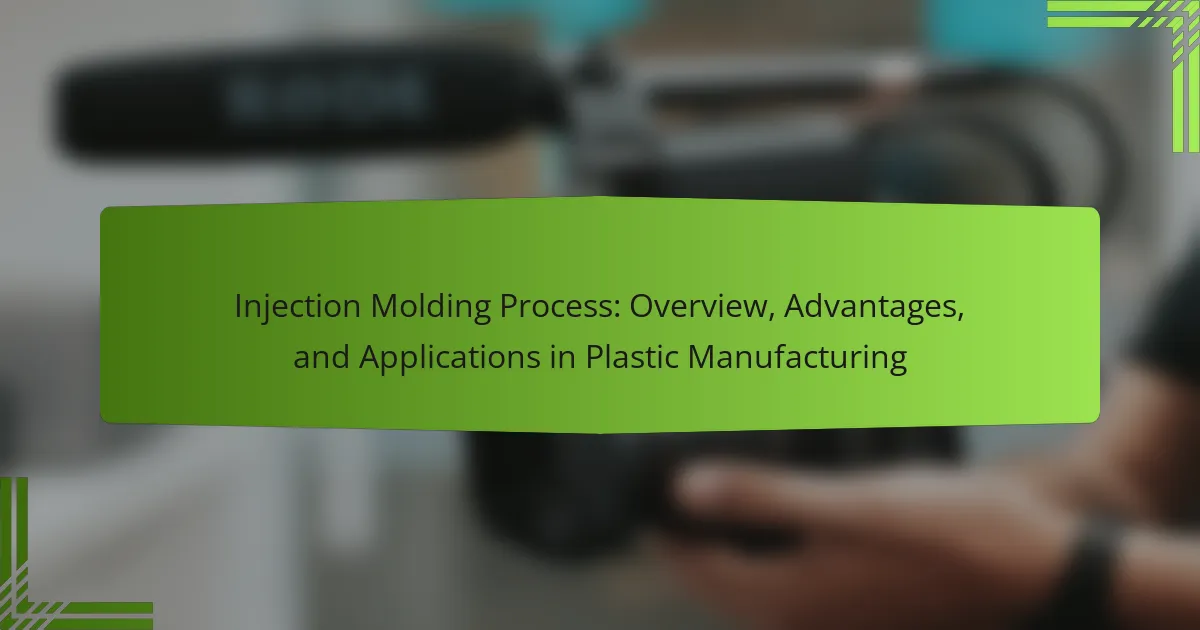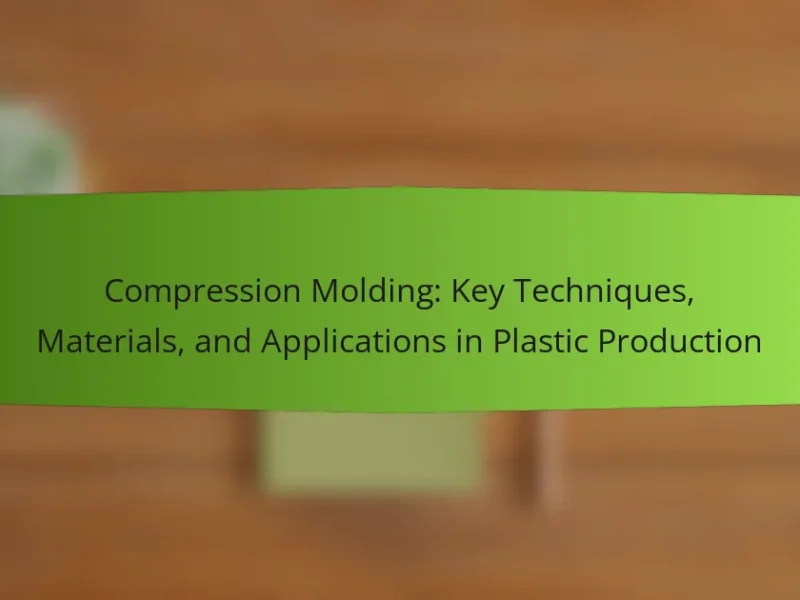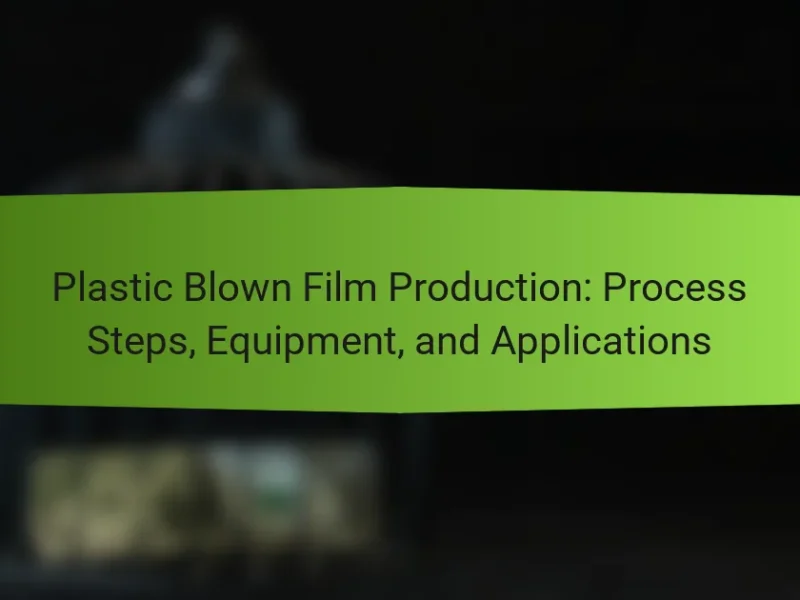The injection molding process is a manufacturing technique used to produce plastic parts by injecting molten material into a mold. This method is characterized by high production rates, consistency in dimensions, and the ability to create complex shapes. Key advantages of injection molding include material efficiency, minimal waste, and automation potential, making it suitable for mass production across various industries such as automotive, consumer goods, and medical devices. The process supports a wide range of materials, including thermoplastics and thermosets, enhancing its versatility in plastic manufacturing. Overall, injection molding is a critical method that facilitates the efficient production of high-quality plastic components.
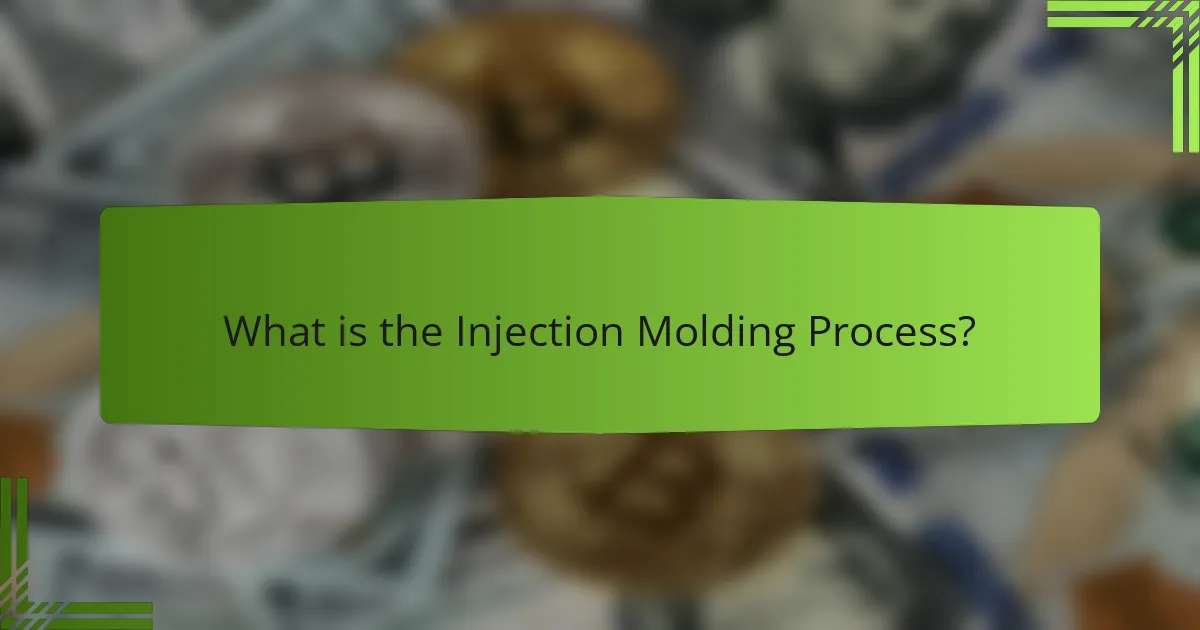
What is the Injection Molding Process?
The injection molding process is a manufacturing technique for producing parts by injecting molten material into a mold. This method is commonly used for plastics, where granules are heated until they melt. The molten plastic is then injected into a mold cavity under pressure. Once cooled, the mold is opened, and the solidified part is ejected. This process allows for high production rates and the creation of complex shapes. Injection molding can produce parts with consistent dimensions and surface finishes. It is widely used in various industries, including automotive, consumer goods, and medical devices. The efficiency of the injection molding process makes it a preferred choice for mass production.
How does the Injection Molding Process work?
The injection molding process works by injecting molten material into a mold to create a specific shape. First, plastic pellets are heated until they melt. This molten plastic is then injected under pressure into a closed mold. The mold is designed to form the desired shape of the final product. Once the plastic cools and solidifies, the mold is opened. The finished part is then ejected from the mold. This process allows for high precision and repeatability in manufacturing. Injection molding is widely used in producing plastic parts for various industries.
What are the key stages involved in the Injection Molding Process?
The key stages involved in the Injection Molding Process are clamping, injection, cooling, and ejection. Clamping secures the mold halves together under pressure. Injection involves forcing molten plastic into the mold cavity. Cooling allows the plastic to solidify and take shape. Ejection removes the finished part from the mold. Each stage is critical for producing high-quality plastic components efficiently.
What materials are commonly used in the Injection Molding Process?
Common materials used in the Injection Molding Process include thermoplastics, thermosetting plastics, and elastomers. Thermoplastics, such as polyethylene and polypropylene, are widely utilized due to their versatility and ease of processing. Thermosetting plastics, like epoxy and phenolic resins, provide high thermal stability and strength. Elastomers, including rubber materials, offer flexibility and resilience. These materials are chosen based on their specific properties and the requirements of the final product. The selection of material affects the performance, durability, and cost of the molded parts.
What are the essential components of an Injection Molding Machine?
The essential components of an Injection Molding Machine include the injection unit, clamping unit, and control system. The injection unit is responsible for melting the plastic and injecting it into the mold. It consists of a hopper, barrel, and screw. The clamping unit holds the mold in place during the injection process. It provides the necessary pressure to keep the mold closed. The control system manages the machine’s operations, including temperature and pressure settings. Each component plays a crucial role in the efficiency and effectiveness of the injection molding process.
How do the components of the machine function together?
The components of an injection molding machine function together through a coordinated process. The injection unit melts plastic pellets and injects the molten material into a mold. The mold is held closed by a clamping unit, which applies pressure to prevent leakage. The cooling system circulates coolant to solidify the plastic inside the mold. Once cooled, the mold opens to eject the finished part. Sensors and controls monitor temperatures and pressures throughout the cycle. This integration ensures efficiency and precision in producing plastic components.
What role does temperature play in the Injection Molding Process?
Temperature plays a crucial role in the Injection Molding Process. It affects the viscosity of the molten plastic. Higher temperatures reduce viscosity, allowing easier flow into the mold. Conversely, lower temperatures increase viscosity, which can lead to incomplete filling.
The temperature also impacts the cooling rate of the molded part. Proper cooling ensures dimensional stability and reduces defects. Inadequate cooling can cause warping and stress in the final product.
The optimal temperature range varies by material, typically between 180°C to 250°C for most thermoplastics. Maintaining correct temperatures is essential for achieving high-quality molded parts.
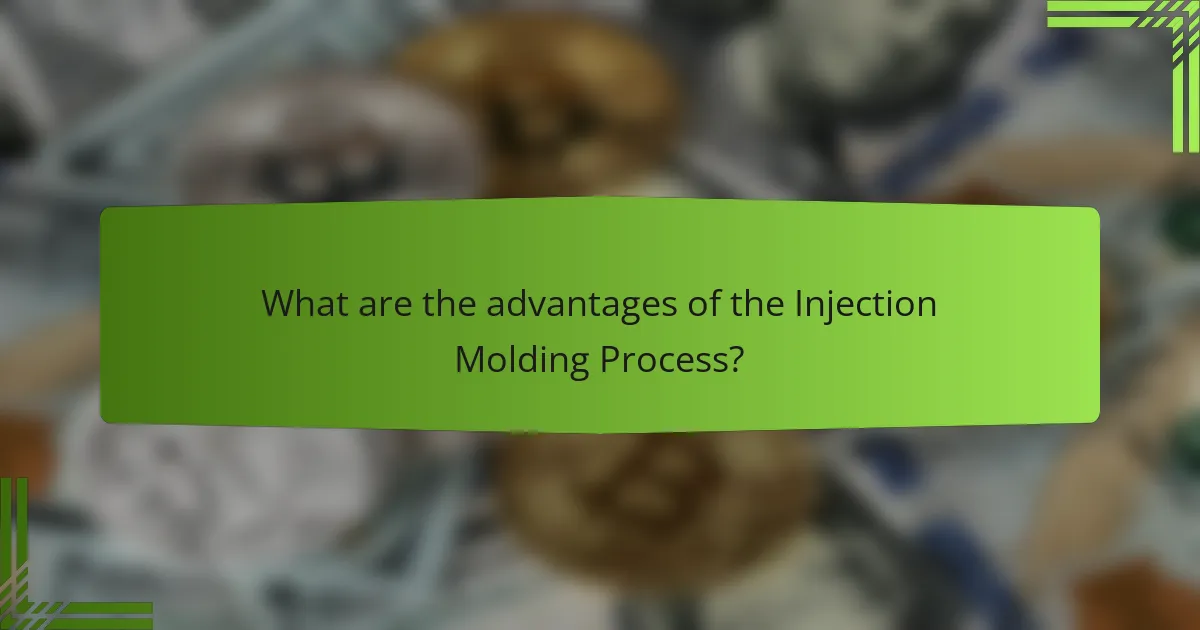
What are the advantages of the Injection Molding Process?
The Injection Molding Process offers several advantages. It allows for high production rates, making it efficient for large-scale manufacturing. The process produces consistent and precise parts with tight tolerances. Material waste is minimized, as excess plastic can be recycled. It supports a wide range of materials, including thermoplastics and thermosets. The ability to create complex shapes is another significant benefit. Additionally, the process enables automation, reducing labor costs and increasing productivity. These advantages contribute to the popularity of injection molding in various industries, including automotive and consumer goods.
Why is Injection Molding considered cost-effective?
Injection molding is considered cost-effective due to its efficiency in mass production. The process allows for the rapid creation of large quantities of identical parts. This scalability reduces the cost per unit significantly. Additionally, injection molding minimizes material waste compared to other manufacturing methods. The precision of the process leads to fewer defects and less rework. According to the Society of Plastics Engineers, production rates can exceed 1000 parts per hour. This high output further contributes to overall cost savings. The initial investment in molds can be high, but the long-term savings in production costs justify this expense.
How does the production speed of Injection Molding compare to other methods?
Injection molding has a significantly higher production speed compared to methods like blow molding and extrusion. Injection molding can produce parts in seconds, with cycle times often ranging from 15 to 60 seconds per part. In contrast, blow molding typically has longer cycle times, often exceeding 30 seconds to several minutes, depending on the part size. Extrusion processes can also be slower, particularly for complex shapes, as they require additional cooling and cutting steps. Studies indicate that injection molding can achieve production rates of up to 10,000 parts per hour for small components. This efficiency makes injection molding the preferred choice for high-volume production in plastic manufacturing.
What are the quality benefits of using the Injection Molding Process?
The Injection Molding Process offers several quality benefits. It produces high-precision components with tight tolerances. This method allows for consistent part quality across large production runs. The materials used can be precisely controlled for uniformity. Injection molding also minimizes waste by utilizing the exact amount of material needed. Additionally, the process enables complex geometries that enhance product functionality. Parts produced are often stronger due to the molecular alignment achieved during molding. Finally, the process supports rapid production cycles, ensuring timely delivery of high-quality products.
What design flexibility does Injection Molding offer?
Injection molding offers significant design flexibility for creating complex shapes and geometries. It allows for intricate detailing and precise dimensions. The process can accommodate various materials, including thermoplastics and thermosets. Designers can create parts with varying wall thicknesses, enhancing structural integrity. Injection molding supports the incorporation of undercuts and complex features. It enables rapid prototyping, allowing for quick adjustments in design. The technology facilitates high-volume production with consistent quality. This flexibility has made injection molding a preferred choice in diverse industries, from automotive to consumer goods.
How can Injection Molding accommodate complex shapes?
Injection molding can accommodate complex shapes through the use of intricate mold designs. The process involves injecting molten plastic into a precisely engineered mold cavity. These molds can feature undercuts, contours, and fine details. Advanced technologies like computer-aided design (CAD) facilitate the creation of these complex molds. The materials used can flow into tight spaces, capturing intricate geometries. Additionally, multi-part molds allow for the assembly of complex shapes in a single process. This capability enables the production of detailed components used in various industries. The precision of injection molding ensures that even the most complex designs can be replicated consistently.
What are the limitations in design when using Injection Molding?
Injection molding has several design limitations. Complex geometries can be challenging due to the need for uniform wall thickness. Features like undercuts may require additional tooling or assembly steps. Draft angles are often necessary for part removal, which can restrict design aesthetics. Additionally, large parts may face warping during cooling. Material selection can also limit design options, as some materials may not flow well into intricate shapes. Finally, the initial cost of molds can be high, impacting design feasibility for low-volume production.
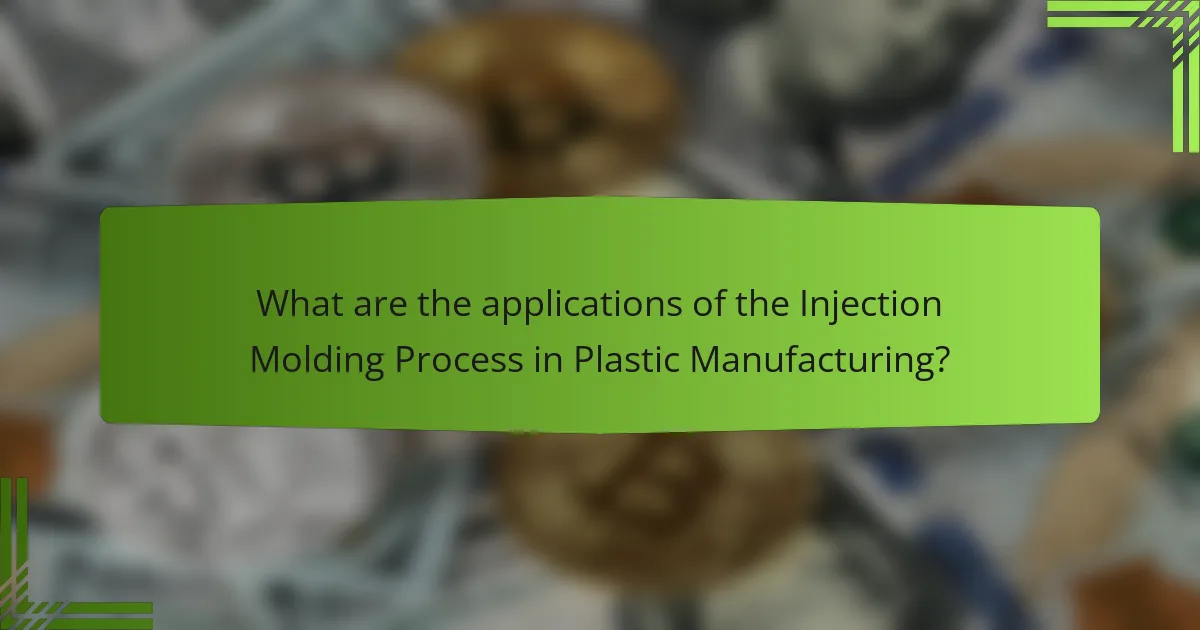
What are the applications of the Injection Molding Process in Plastic Manufacturing?
The Injection Molding Process is widely applied in plastic manufacturing for producing a variety of components. It is used to create items such as automotive parts, consumer goods, medical devices, and packaging materials. The process allows for high-volume production with consistent quality and precision. It can produce complex shapes and intricate designs that are difficult to achieve with other manufacturing methods. Additionally, injection molding is efficient, reducing material waste and energy consumption. The versatility of the process accommodates different types of plastics, enhancing its applicability across industries. Overall, injection molding is a crucial method for modern plastic manufacturing.
Which industries utilize the Injection Molding Process?
The injection molding process is utilized across various industries. Key industries include automotive, consumer goods, medical, and packaging. In the automotive sector, injection molding produces components like dashboards and bumpers. Consumer goods companies use it for items such as toys and kitchenware. The medical industry relies on injection molding for devices and packaging. Additionally, the packaging industry employs this process for creating containers and closures. Each of these sectors benefits from the efficiency and precision of injection molding.
How is Injection Molding used in consumer product manufacturing?
Injection molding is used in consumer product manufacturing to create a wide array of plastic items. This process involves injecting molten plastic into a mold to form specific shapes. It allows for high-volume production with consistent quality and precision. Products such as containers, toys, and electronic housings are commonly made using this method. Injection molding can produce complex designs that would be difficult or costly with other manufacturing techniques. The process is efficient, reducing material waste and production time. Additionally, it supports various plastic materials, enhancing versatility in product design. Overall, injection molding is a key technique in modern consumer product manufacturing.
What role does Injection Molding play in automotive manufacturing?
Injection molding plays a crucial role in automotive manufacturing by enabling the production of complex plastic parts efficiently. This process allows manufacturers to create components with high precision and consistency. Injection molding is widely used for producing interior and exterior automotive parts, such as dashboards, bumpers, and trim pieces. The method supports rapid production, reducing lead times and costs. According to industry reports, injection molding can produce thousands of parts per hour, making it ideal for mass production. Additionally, it allows for the use of various materials, including thermoplastics and thermosets, which are essential for meeting automotive standards. The ability to incorporate design features, such as undercuts and intricate geometries, further enhances the versatility of injection molding in the automotive sector.
What types of products are commonly produced using Injection Molding?
Injection molding is commonly used to produce a wide range of plastic products. These include consumer goods like containers, toys, and household items. Automotive parts such as dashboards, bumpers, and interior components are also manufactured through this process. Additionally, medical devices and components, including syringes and surgical instruments, are produced using injection molding. The versatility of this manufacturing technique allows for complex shapes and high-volume production. According to industry reports, injection molding accounts for approximately 30% of all plastic production globally.
What are the most common plastic items created through Injection Molding?
The most common plastic items created through injection molding include containers, automotive parts, and consumer goods. Containers such as bottles and caps are widely produced using this method. Automotive parts like dashboard components and bumpers are also frequently made through injection molding. Additionally, consumer goods such as toys and kitchen utensils are commonly manufactured using this process. Injection molding allows for high precision and efficiency in producing these items. The versatility of materials used in injection molding further supports the production of diverse plastic products.
How does Injection Molding contribute to the production of medical devices?
Injection molding significantly contributes to the production of medical devices by enabling high precision and consistency in manufacturing. This process allows for the creation of complex shapes and intricate designs that are often required in medical applications. The materials used in injection molding can be biocompatible, ensuring safety for medical use. Additionally, the speed of production is enhanced, allowing for large volumes of devices to be manufactured efficiently. According to industry reports, injection molding can reduce production costs by up to 50% compared to traditional manufacturing methods. The ability to produce lightweight and durable components further enhances the performance of medical devices. Overall, injection molding is essential for meeting the rigorous standards of the medical industry.
What best practices should be followed in the Injection Molding Process?
Best practices in the injection molding process include optimizing the mold design, selecting appropriate materials, and controlling processing parameters. Proper mold design ensures uniform cooling and minimizes defects. Choosing the right materials affects product quality and performance. Precise control of temperature, pressure, and cycle times enhances efficiency and consistency. Regular maintenance of equipment prevents breakdowns and ensures reliability. Implementing quality control measures during production helps identify and rectify defects early. Training operators on best practices improves overall operational efficiency. These practices lead to higher quality products and reduced production costs.
The Injection Molding Process is a manufacturing technique that produces parts by injecting molten material into a mold, primarily used for plastics. This article provides an overview of the process, detailing its key stages, materials, and essential components of the injection molding machine. It also highlights the advantages of injection molding, including high production rates, cost-effectiveness, and design flexibility, while discussing its applications across various industries such as automotive, consumer goods, and medical devices. Best practices for optimizing the injection molding process are also outlined to ensure efficiency and product quality.
